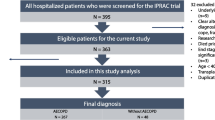Abstract
Objectives
WHO to examine the value of additional markers like history of previous respiratory distress and response to bronchodilator (BD) to redefine these guidelines.
Methods
Fifty (50) patients were analysed for presence of fever. Those who were febrile were put on antipyretic to look for resolution of tachypnea. Those who showed persistent tachypnea and those who were afebrile were analyzed for history of previous respiratory distress. Those who gave a positive history were challenged with BD. The association of persistent tachypnea and pulmonary infiltrates was recorded.
Results
Persistence of tachypnea after BD therapy was associated with pulmonary infiltrate in 7/8(87.5 %) whereas tachypnea persisted in 9/30 (30%) of those without infiltrates (p < 0.001). The proposed algorithm brings down the overuse of antibiotics from 78.9% to 26.3% (p <0.001) and also brings down the underuse of bronchodilators from 78.9% to 21.1 %(p<0.001).
Conclusion
Adding simple markers like history of previous respiratory distress and response to BD therapy to the existing WHO guidelines it is possible to reliably differentiate pneumonia from acute exacerbation of asthma.
Similar content being viewed by others
References
World Health Organization. Conquering Suffering Enriching Humanity, Geneva. World Health Organization, 1997.
World Health Organization. Technical basis for WHO recommendations on the management of pneumonia in children at first level health facilities. Geneva, WHO, Document WHO / ARI / 91-120.1991.
Acute Respiratory Infections in children: Case Management in Small Hospitals in Developing Countries — A Manual for Doctors and Senior Health Workers. Geneva, World Health Organization Document WHO/ARI/90.05.1990.
Berman S. Epidemiology of acute respiratory tract infections in children of developing countries. Rev Infect Dis 1991; 13(S6): S454–462.
Che WFT, Foh Dyt, Lec BW. Epidemiological surveys on the prevalence of childhood asthma, rhinitis and eczema worldwide. Singapore Pediatr Journal 1996; 38: 74–96.
Sachdev HPS, Vasanthi B. Sathyanarayana L, Puri RK. Simple Predictors to differentiate acute asthma from ARI in children: Implications for refining care management in ARI control Program. Indian Pediatr 1994; 31: 1251–1259.
Castro AV, Narcimento-Carvalho CM, Ney-Oliveira F, Araujo-Neto CA, Andrade SCS, Loureiro LLS. and Luz PO. Additional Markers to Refine the World Health Organization Algorithm for Diagnosis of Pneumonia. Indian Pediatr 2005; 42: 773–781.
Steering committee of the International Study of Asthma and Allergies in Childhood (ISAAC). Worldwide prevalence of symptoms of asthma, allergic rhino-conjunctivitis and atopic asthma. Lancet 1998; 351: 1221–1232.
Paramesh H, Epidemiology of asthma in India. Indian J Pediatr 2002; 69: 309–312.
Straus WL, Qazi SA, Kundi Z. Antimicrobial resistance and clinical effectiveness of co-trimoxazole versus Amoxicillin for pneumonia among children in Pakistan; Randomized controlled trial. Lancet 1998; 352: 270–274.
Baquero F, Martine Z-Beltran J, Loza E. A review of antibiotic resistance patterns of streptococcus pneumonia in Europe. J Antimicrob Chemother 1991; 28: 31–38.
Shally Awasthi, Ekta Sarla, Siddharta Roy, Saumya Awasthi. Prevalance and risk factors of asthma and wheeze in school going children in Lucknow, North India. Indian Pediatr 2004; 41: 1205–1210.
Weiss KB, Wagenar DK, Changing pattern of asthma mortality: Identifying target population at risk. JAMA 1990; 264: 1683–1687.
World Health Organization. Standardization of interpretation of chest radiographs for the diagnosis of pneumonia in children. Geneva. 2001
Taylor JA, Deal Beccaro M, Done S, Winters W, Establishing clinically relevant standards for tachypnea in febrile children younger than 2 years. Arch Pediatr Adolesc Med 1995; 149: 283–287.
Author information
Authors and Affiliations
Corresponding author
Rights and permissions
About this article
Cite this article
Savitha, M.R., Khanagavi, J.B. Redefining the world health organization algorithm for diagnosis of pneumonia with simple additional markers. Indian J Pediatr 75, 561–565 (2008). https://doi.org/10.1007/s12098-008-0108-4
Received:
Accepted:
Published:
Issue Date:
DOI: https://doi.org/10.1007/s12098-008-0108-4




